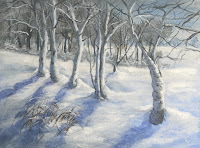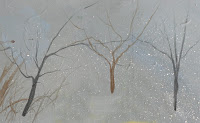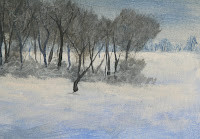ACRYLIC CLASS Week 3 – Snow Demo
 Torrance
Torrance
This was the final week for our snow/white painting, the main point to this exercise is no matter what the subject is if it is white you need to have dark to show it off. It doesn't matter whether it is snow, lace, fur or whatever, if you want it to have depth and texture you need to have the contrast in values to show the white off. You can see this in the everyday things around you and in the works of other artists, the more you look for these things the more you will understand them.
I finished the middle ground trees by adding a few more branches also some touches of white tinted with a touch of orange on my flat bristle brush to suggest snow in the tops of the trees, I did this by taping straight on with my brush very lightly. Remember the harder to press down on your brush – any brush – the more paint will come off it, if you don't want a lot of paint you don't press too hard.

On the snow in front of the trees, I dry brushed in some more highlight. Again it is white with just a tiny touch of orange to slightly tint it. White can look too chalky by itself so we limit using pure white until the very final highlights. Do not cover up all of what you have down, just add to it , you need those previous layers to show depth, contour and texture.
When that was dry, I used my charcoal to sketch in my foreground trees and a few of the main branches. This is where your artistic license comes in. You can move, remove, add or subtract elements as you see fit, it is your right and sometimes, duty, as an artist. Your utmost concern is for the composition of the painting so you do what ever it takes to make the best painting you can. I thought that the trees in the picture were 1, too small and 2, were in too straight and horizontal of a line so I made them bigger and changed the angle slightly to make it more pleasant a composition. I also sketched the snow drifted up against the bottoms of the trees.
I based in the trees with a medium grey color (blue, sienna and white, touch of purple) and I used a smaller bristle brush. When I was forming my tree trunks, in the larger parts of the trunks I started on an outside edge with the end of the brush on that edge and made small "u" shaped strokes to create the trunks. A tree is not flat, it is usually a rounded shape. The brush strokes you use can be critical in explaining to your viewer that it is a 3 dimensional object. Your brush strokes have meaning and are an important element to the successful completion of your painting.
I also started highlighting the snow in the foreground around the trees again with the white and a touch of orange on my bristle brush and the dry brush stroke. Keep in mind what you are trying to do which is to suggest snow that has fallen over a field that could be full of rocks, logs, clumps of grass or what ever you might find in a field so again, don't cover up all of the under painting you did it becomes the dips and the texture you will need in the snow. You may have to go over the snow several times to get the brightest areas to be as light as you want them but each time you go over, leave some of what you did before to make your snow more interesting.
When you are doing this highlighting, don't worry about going over the edges of your trees you are still working on them anyway, the problem occurs when you try to avoid something then you end up with a halo around it. With acrylics you can always paint it back, no problem.
When I started highlighting the trees, I wanted a color that was just a shade or two lighter than the first gray color so if you have some gray on your palette, add some white and a touch of orange to it or just mix some of the mud on your palette to get a light color. Same little "U" stroke but this time it only goes about half way around the trunk all the way up.
This next step may sound a bit strange to new or beginning students, you will just have to trust me on this for now, but on the back side I took my blue and purple and a little white to make a lavender color and with the same "U" stroke I put this in the shadowed side. Purple is your natural shadow color because it is what is left of the spectrum of light as it is scattered and absorbed by things in the real world. This is especially true when there is snow, water or white buildings nearby. Other colors can reflect in the shadows but you will always find blues and purples. It helps your trees look round.
At this point I went in with my liner brush and the gray I used for the trunks and added in all my branches. Look at the photo, you will see A LOT of branches and twigs of all sizes, dark and light and coming from all directions. You will have problems if you don't put enough of these in. When you start our branch, start back in part of the tree then "branch off". This will give a more natural look to the branch rather than starting at the edge of the trunk or branch.
When I got all my branches in, I did some more highlighting on the trees and branches. This time it was mostly white with a touch of orange, smaller "u" shapes and I think I was using my #4 flat sable brush, it gives me a bit more control. I added some of the scaring you see on the trunks by using a dark color (blue, sienna and purple, little or no white) and I dry brushed some shapes and lines on the trunks. Remember the trunks are round so any horizontal lines on the trunks need to be slightly curved.
The trees are also casting shadows which we need to get in. Using just the blue and purple and enough water to thin it down to create a wash (very thin paint), the shadow will start at the base of the tree and angle off to the left. Here is the thing to watch out for: you must remember that the shadows follow the terrain so they are not nice straight shadows they may go up and over something or down a depression so with this thin paint dry brush this color onto the snow for your shadows.
The rest is adjustments and detail. You can add in the dead grasses in the foreground and more highlights to make the trees and snow stand out. You can use pure white for the very final highlights on the tree trunks and for some of the snow, but really finishing it is up to you as to how much detail you want. If you are looking for something to do it is probably finished. Stop. You can fiddle a painting to death trying to make it perfect. It is better to leave it for a few days then go back and look at it, if it is something glaring, it will jump out at you, if it doesn't, you were done.
Next class I will be doing another demo on white, but in a different way so if you want to give it a try you will need another canvas or you can work on your own project. If you want to follow along, please download and print out the poppy picture from the picture page for this exercise. I will be doing demos in class for the rest of the semester so you might want to have a canvas just for practice. See you all soon.






